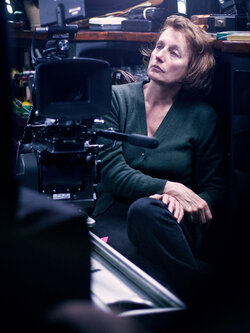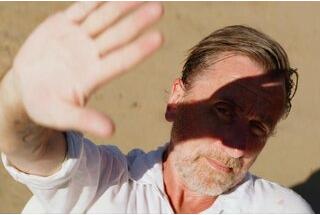Cinematographer Caroline Champetier, AFC, discusses her work on "Holy Motors" by Léos Carax
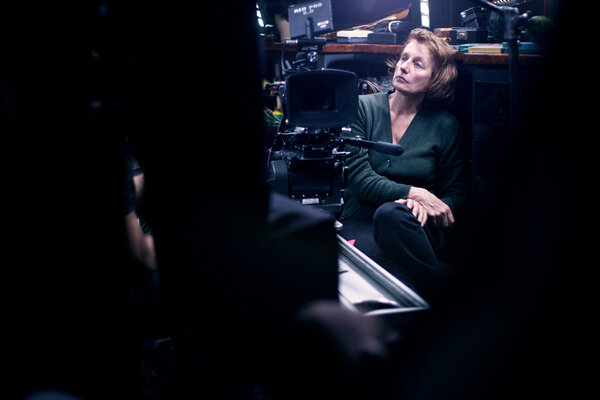
How is the film constructed ?
Caroline Champetier : The screenplay is made up of ten segments that all take place over 24 hours. A day and a night that are also representative of the entire lives of the characters, be they a monster or a killer, a family man or an old man bequeathing his entire fortune to his niece.
A variation on the human condition and an investigation into all of the possibilities of an actor such as Denis Lavant. From this point of view, this film is also a tribute by Léos Carax to Denis Lavant, who has been his alter ego since Boy Meets Girl and all of the actors and actrices.
From a cinematographic point of view, the screenplay was made up of contradictory technical imperatives. What we had designed for the images of Merde – the speed and the disappearance of the camera, night-time shots in the streets, the grottoes, the special effects – had to be multiplied this time. We had to find a camera that could delve into almost total darkness, capture outdoor daytime light, sunrises, and take movement shots from inside the little cabin of a crane or a dolly, while allowing for VFX. All this had to be done with the ergonomics of a camcorder like the DVX100 but with a large sensor. Each scene required us to solve a technical challenge that was often the opposite of the previous one !
Did switching from the DVX100 to the Red Epic cause any staging problems in terms of ergonomics ?
CC : The weight and size of the Red Epic never bothered me for the shots inside the limousine. On the contrary, I even felt the same way I did while we were filming Merde four years ago in Tokyo. Thanks to the preparation work on the camera we did with my assistants Stephen Mack and Bruno Raquillet, we were able to power it using a cable by only keeping the basics (lens and camera body), which makes it about the same size and weight as a big digital camera, and device changes were able to occur rapidly. I don’t like when a lens weighs down the camera. I am nostalgic for the little Cookes, and should have bought a series of them.
For Holy Motors we used old Zeiss T2.1 lenses, which are very light and compact, and that I often used for my work with Jean-Luc Godard. To tell the truth, I like using lenses more for what they are than for the result they give, because I rework that using lighting or filters. This choice is absolutely contradictory to the enfatuation with modern lenses like Master Prime or Cooke S5 that seem to compete for the title of best in class. But being best in class can be dangerous with large sensors like the Epic’s, which, as compared to the flexibility of a negative, give highly-defined and dry results.
There does not exist an idea camera or an ideal lens for what we wanted to do with Holy Motors, and Léos Carax and I had long toyed with the idea of filming using silver-process film with a Penelope and an A-Minima Super 16 in the limousine. Léos and the Directors of Photography with whom he had worked before, Jean-Yves Escoffier and Eric Gautier, had used both media, but there were budgetary constraints and the Super 16 at 400 or 500 ISO couldn’t hold up to the sensitivity of the Epic’s sensor in low light and its rendering of black.
And for night-time shots, didn’t you use any brighter lenses ?
CC : Practically the entire film was filmed at night-time, the question did not arise in those terms. There was one set, one scene in the film where we were obliged to work with an urban light that I couldn’t control : the rooftop terrace of the Samaritaine department store in Paris. Besides asking for certain public buildings to be lit, which I did, I had to comply with what makes Paris at night : sodium, for one, which I brought towards golden-yellow rather than orange.
For that scene in particular, we brought out the wide-aperture lenses, but we realized that the Red Epic’s sensor didn’t put up well with that type of lens when they are used at maximum aperture. You end up with flat tints in the highlights that make the image look unfocused. I think that is in the nature of the CMOS target, which is unable to properly handle receiving the marginal rays that are inherent to wide apertures.
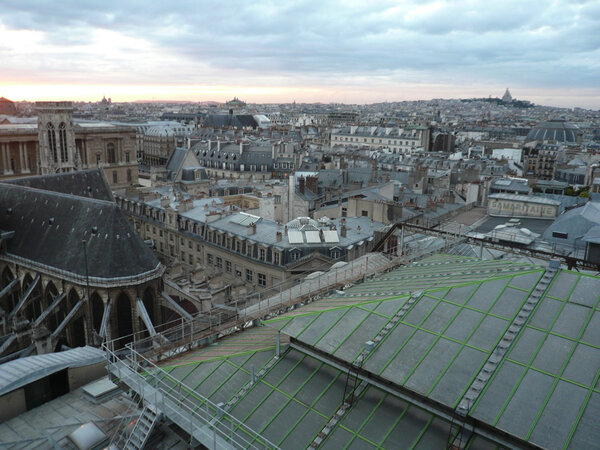
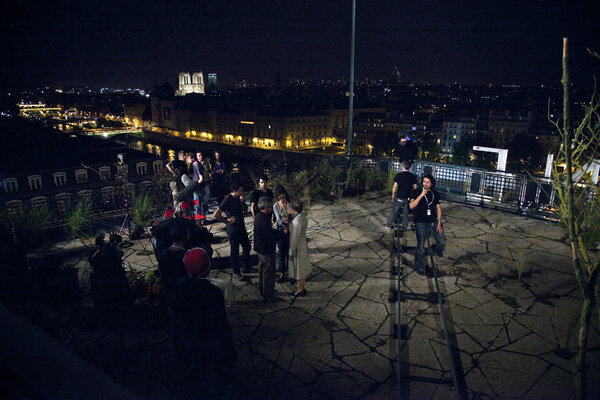
What light sources did you use ?
CC : The wide variety of shooting conditions meant that we needed different electric equipment for every scene. The opening of the film takes place at dawn and made it necessary for me to shift the aperture from 2.8 all the way to 16. For the inside of the limousine, the light came from sources that were part of the set and little LEDs that we brought in. In the Samaritaine, which is currently a construction site that looks like an abandoned ship, Stephane Bourgoin and I constructed the lighting by using existing sources (fluorescent tubes and construction lighting here and there). We arranged sources of a similar nature and worked outside, in the rue de l’Arbre-Sec, on the façade of the church of Saint-Germain l’Auxerrois, and especially on the glass domed roof.
We had to use more than 300 kilowatts of light to light up the entire scene, including what we had placed outside of the place itself, because Léos Carax and I wanted the inside dimness to be lit from outside. For three nights, we used a 100 kW Softsun suspended on an 80m crane. You could see it from Ménilmontant ! Albert Prévost, the Production Manager, helped us make these sometimes-costly choices. In its own way, the film was an erudite and risky construction.
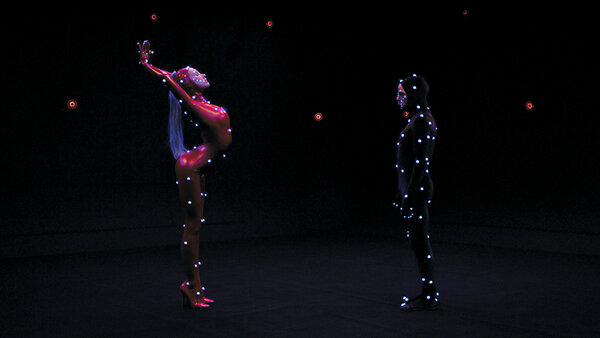
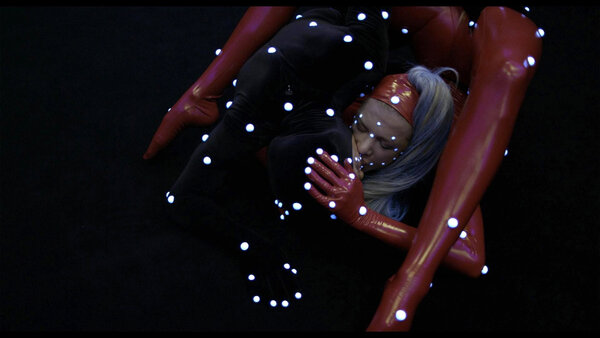
For the scene filmed with the Motion Capture, we had to create an illuminated costume for acrobat Denis Lavant using phosphorescent balls that we lit using black light and sometimes tungsten lights, which created the scintillation and dimming of the light. Léos Carax is always pushing the limits of what is technologically possible ; he’s got a bit of Cocteau in him for that. These technological challenges are also the soul of this film, like Bernard Floch’s makeup work, the soul of the cinema was blowing over the creation of this film like it rarely has over any set before.
The film must have required a lot of preparation. What is Léos Carax’s approach to this ?
CC : Holy Motors’ screenplay was a real “old-fashioned” working tool that Léos Carax fed as we went forth with our preparations by adding photos he took on location, with his intentions for the camerawork and the ambiance. We did a lot of location scouting and rehearsals for each important set. For the Samaritaine scene, we did a dozen technical scouting sessions and then we rehearsed with Kylie Minogue. Also, the musical scene in the Saint-Merri Church, which is a sort of musical interlude in the middle of the film, required five weekends in a row in order to get the master shot just right, where the Steadicam ends up on a crane in order to film almost the entire place.
Some sets that we had scouted out far in advanced ended up disappearing, such as the scene with the double murder that was originally supposed to be filmed outside at night-time in the heart of Paris’ Chinatown (Tolbiac area in the 13th arrondissement). But, we had a lot of problems with the condo association that ran the place and finally we had to give up. So we used a sort of infinite basement for the double murder, made up of an underground city of streets, parking lots, and warehouses.
The scene where Kylie Minogue climbs over the railing...
CC : The precision of the angle, the height and the focal allowed us to create the illusion that there was nothing below. In reality, the overhang that Kylie Minogue was walking on is right above a part of the roof that is just below. A mattress and a stuntman were enough to create the effect. A few centimetres difference were enough to create the vertigo. For the shadows, we chose buildings that we wanted to keep lit, one after the other, like child’s play.
How did you film the many scenes shot inside the car ?
CC : First, we thought we would shoot in a real limousine. The first tests with Denis and the little DVX 100 took place in May 2011. Léos liked the resulting images, both daytime and night-time. Then we had to answer the question of whether we would film like that, or build a set in the studio. Since we only had a budget of 3.9 million Euros, the extra cost of filming in a studio would have been significant. But, given the absolute shambles that Léos wanted the inside of that limo to look like, the sort of “storage room” that he wanted to make it into, we decided that the only viable solution was to order a made-to-measure fake inside of a limo.
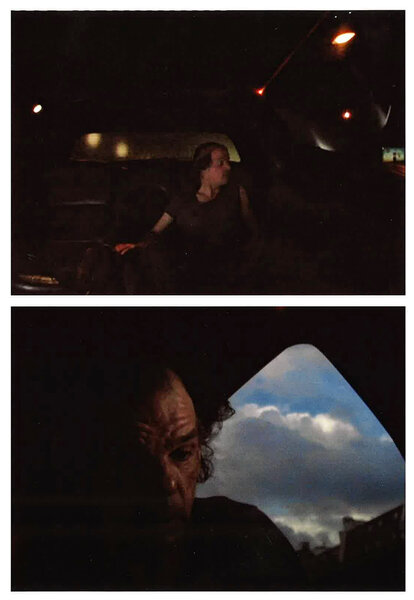
Florian Sanson, the art director, had the rear of the limo built and slightly widened, and then attached to the front of a real limo, which allowed us to much more cheaply get a real windshield, the window between the driver and the passenger compartments, and the driver’s compartment itself.
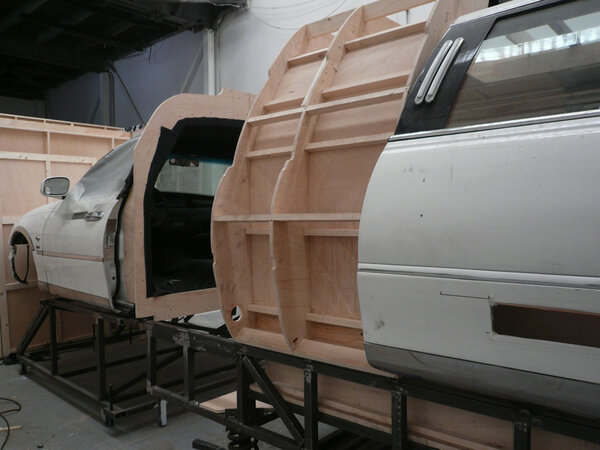
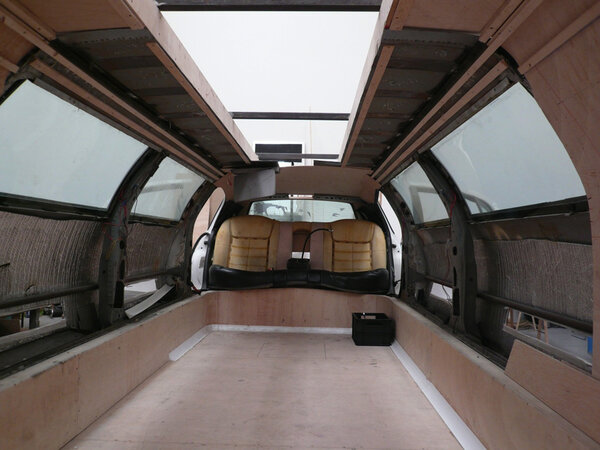
The openings were created by Alexandre Bon and Christophe Grelié based on an idea suggested by Jean-Pierre Beauviala. It was an ingenious compact system of frontal spotlights using five HD video spotlights that were suspended on a structure above the roof of the limousine. A sixth spotlight was placed within the axis of the windshield to get a brighter image.
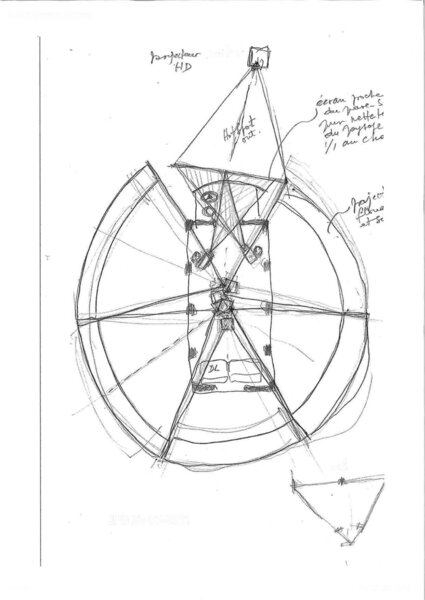
Why did you have two different lighting systems ?
CC : To simulate the difference in brightness of the light that came through the windshield, which isn’t made of tinted glass, and the passenger windows, which are supposed to be tinted black like in any limousine. For optical reasons, we thought it better to equip the whole car with clear windows and diminish the brightness of the spotlights accordingly in order to create the illusion of tinted windows.
Thanks to the calibration of the onion skins (that were filmed using RED One) and the correction of perspective on the six screens, I think that we successfully reproduced the tone and spirit of the original images that were captured during our trials in the real limousine…blurry, allusive images that are more poetic than realistic.
Did you filter ?
CC : Each new target needs its own filter structure. We were late in finalizing our decision to use the Red Epic and I didn’t have enough time to do enough serious tests as far as filters were concerned. So, I didn’t filter very much, except during the scene at the Raphaël, which was one of the most “classic” scenes in the film, and where I wanted to bring back “silver process” texture using a Tiffen Glimmer.
This camera, whether it is used in 4K or 5K, intrinsically gives images a sensation of over-definition which bothered me, and even more so on the master video, to which we added a “blur” effect in order to reduce the HD feeling. Nonetheless, the Red Epic makes up for it thanks to its excellent restitution of dark colours and skin tone.
Were you disappointed by some scenes ?
CC : The outside scenes filmed in daylight are still problematic. The skies, for example, seem like painted clouds whenever we filmed them in sunny weather. It was impossible to achieve the depth and calibration of film, and with this camera there is no solution. I really think that that is related to the sensor, and we’ll just have to make do while we wait for the Penelope-Delta whose trials seem to be highly promising as far as the highlights are concerned.
At what sensitivity did you use the camera ?
CC : I used the camera at a speed of 640 ISO while filming inside and at night-time, and at a speed of 800 ISO while filming outside in daylight. This might seem unusual, but it enabled me to preserve the lowlights at night-time and the highlights in daylight. Of course, that means that I had to use very dense, neutral filters that also cut the infrared and go up to ND24.
You shared the credit for the photography with Yves Cape. How was it working with him ?
CC : Because shooting had begun late and I was already engaged to work on another film right afterwards, I wasn’t able to finish working on Holy Motors. I asked Yves Cape to come replace me at the end of shooting. His work demonstrated great intelligence and flexibility. It’s not always easy to start working at the end of a film.
He already knew a part of the team, including the gaffer, Stéphane Bourgoin, with whom he had already shot a number of films. The scenes that he filmed were those at the Père Lachaise cemetery and the scene in the grotto, where Léos wanted to push the Red Epic to the very limits of its abilities to film in darkness…which did not make his work any easier !
It seems to me that these digital camera sensors literally feed off of light. Sometimes, a single point of light in the frame enables the image to come to life, even in the deepest darkness. On the other hand, a flat tint grey graduation throws the camera out of whack and can harm the image. That is why calibration is essential for understanding the limits of these sensors.
We calibrated the film with Alexandra Pocquet who has been working with me since Un couple parfait by Nobuhiro Suwa. Like most female calibrators, she is very precise in her relationship to black. That is what she starts working with on every image, and the rest comes second. Especially since we had hoped from the very beginning to finalize the film in 4K. I remarked, however, that when we put out the first release prints on 35mm film, the black looked better, especially when it was screened on Silver screens. We did a comparative screen test in the same theatre for the opening of Paris Cinema. Strangely enough, nobody had done the comparison before.
To conclude ?
CC : As always, the imagination of great directors like Léos Carax brings us unprecedented images through the use of new tools in new ways. It is wonderful to find oneself confronted in one project with such risks and such opportunities to create a full range of visual emotions that become the language of the film.
I would like to point out that the entire team on set was extraordinarily united around Léos’ assistants, Julie Gouet and Yann Chemin, and that editor Nelly Quetier never had an instant of complacency. There were also all of the suppliers who supported us along the way, both technically and financially, and sometimes at great risk. All of these people dreamed about this film, and we are also happy and proud for them that the film is going to be screened on the Auditorium Lumière’s 25-meter-high screen.
(Interview conducted by François Reumont for the AFC and translated from French by Alex Raiffe)
Storyline
From dawn to dusk, a few hours from the life of Monsieur Oscar, a being who travels between different lives. Simultaneously captain of industry, murderer, beggar, monster, father…Mr. Oscar seems to play each role to its fullest—but where are the cameras ? He is alone, only accompanied by Celine, a long blond woman who controls the immense machine that transports him through Paris and its suburbs. Like a conscientious hit man, going from target to target. Looking for beauty for beauty’s sake. Looking for the driving force. The women and ghosts that haunt his life. But where are his home, his family, his rest ?
 En
En Fr
Fr
